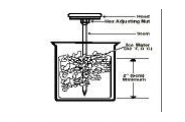Temperature control is essential to food safety, and using a thermometer is an integral part of temperature control. Every food handler should know how to use and calibrate a thermometer. This fact sheet will help guide you through the basics of selecting, using, and calibrating several types of food service thermometers
Types of Thermometers
Thermocouples:
Thermocouples measure temperature through a sensor in the tip of the stem. When the user presses a button, the thermocouple gives a readout of the temperature. This type of thermometer measures temperatures quickly and only requires re-calibration sometimes.
Bi-metallic stemmed thermometers:
The bi-metallic stemmed thermometer is the most common type of food service thermometer. It measures temperature through a metal stem with a sensor in the lower end. The sensing area is from the tip to a half-inch past the dimple. The temperature is read on the dial face. When selecting this type, look for an adjustable calibration nut, easy-to-read temperature markings, and a dimple marking the end of the sensing area. These should not be left in food that cooks in an oven, a microwave, or a stovetop.
Digital thermometers:
Digital thermometers measure temperatures through a metal tip or sensing area. They are straightforward to read because they have a digital readout.
Other Types of Foodservice Thermometers
Time-temperature indicator (TTI):
A kind of thermometer strip that is usually found on packages and looks like a label. Liquid crystals in the strip change color if foods reach an unsafe temperature.
Candy, Meat, and Deep-fry Thermometers:
They are used for only one type of food. Never use mercury-filled or glass thermometers because they may break.
Equipment Thermometers:
Usually built-in or of the hand-type and are found in refrigerator or freezer units. Others are built into hot-holding equipment and dishwashing machines.
Calibrating Your Thermometer
Periodically, all thermometers should be calibrated or adjusted to measure temperatures accurately.
Here's how:
Bimetallic Stemmed Thermometers:
Bimetallic stemmed thermometers are calibrated using the ice-point method. Calibrate regularly after using the thermometer with very hot or cold foods or after dropping or jarring them. In a clean styrofoam cup, make an ice water slush by filling the cup halfway with ice cubes and the rest with water. Place the sensing tip of the thermometer into the cup, ensuring not to touch the sides or bottom of the cup. Wait four or five minutes or until the needle is steady. If the needle does not read 32 degrees F (0 degrees C), turn the nut under the dial until it does. Clean and sanitize the thermometer and its case before the next use.
Thermocouples and Digital Thermometers:
Check the accuracy of thermocouples and digital thermometers regularly using the ice point method described above. If the reading is off, try a new battery. If that does not correct the problem, then have the thermometer checked.
Using Thermometers
Cleaning and Sanitizing:
Before and after each use, wash, rinse, sanitize, and air-dry thermometer stems. Use a sanitizing solution that is safe for food-contact items.
Taking Temperatures:
Depending on the food being checked, there are several methods for measuring food temperatures:
- Stick the sensing tip into the center or thickest part of the food. Check the temperature in at least two places.
- For flexible packages or soft bulk dispensers, fold the container around the sensing tip of the thermometer. Do not poke a hole in the box.
- For individual packages, such as small milk cartons, open one box and insert the thermometer. Throw away the open container or use it immediately for cooking.
- For frozen foods, stick the sensing area between packages or tightly packed boxes.
Materials in the For Safety's Sake series were produced by members of a special Food Safety Agent Resource Team and have reviewed by individuals from Family & Consumer Sciences and The Food Science Department at North Carolina State University.
Publication Title: Measuring the Heat - (FSS5)
Original Publication Date: November 1998
Publication date: Dec. 29, 1998
N.C. Cooperative Extension prohibits discrimination and harassment regardless of age, color, disability, family and marital status, gender identity, national origin, political beliefs, race, religion, sex (including pregnancy), sexual orientation and veteran status.





